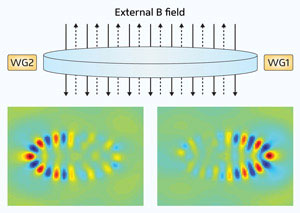| Posted: March 3, 2010 |
Nanophotonics: Bright attractions |
|
(Nanowerk News) Semiconductor microcavity lasers are attractive as building blocks for nanophotonics applications, such as optical switches, sensors and ultrasmall light sources for optical computing, but their successful integration hinges on the efficient extraction of the light energy therein. This efficiency could be increased significantly by applying an external magnetic field to elliptically shaped microcavities, according to the results of a numerical study by Eng Huat Khoo and co-workers from the Institute of High Performance Computing, A*STAR, Singapore ("Enhancement of light energy extraction from elliptical microcavity using external magnetic field for switching applications").
|
|
When electrons are trapped in microscale cavities, quantum physics dictates that they can only assume certain discrete energies. This energy ‘quantization’ is beneficial when incident light is trapped along with the electrons because, under the right circumstances, their mutual interaction produces highly efficient monochromatic laser light following transitions between the well-defined energy levels within the cavity.
|
|
The laser light can be extracted from the cavity by placing an optical waveguide adjacent to it. At an optimum distance, photons—the basic ‘unit’ of light—can jump from the cavity to the waveguide via quantum mechanical tunneling.
|
 |
| Fig. 1: A schematic depiction of a perpendicularly applied magnetic field that localizes electrons to the minor arcs of an elliptical microcavity laser (lower panels show the calculated electric-field distribution), thereby increasing the efficiency with which the light energy can be extracted to neighboring waveguides (WG1 and WG2). The directionality of the extracted light depends on the direction of the magnetic field. (Reproduced in part, with permission, from Ref. 1 © 2009 American Institute of Physics)
|
|
The novel idea of Khoo and co-workers was to localize as many electrons as possible—and through that, the photons—to the cavity edge closest to the waveguide to maximize the light extraction. Their quantum mechanical calculations show that applying a magnetic field perpendicular to an elliptical microdisk serves this purpose beautifully (Fig. 1).
|
|
“The electrons are forced to move to one edge of the cavity by the Lorentz force,” explains team-member Iftikhar Ahmed. At an optimum strength of magnetic field and current density through the device, and an optimum distance between the cavity and waveguide, the light extraction efficiency can be enhanced up to 34% compared to the no-field case.
|
|
Furthermore, they demonstrate that by switching the direction of the external magnetic field, the electrons accumulate at either of the minor arcs of the elliptical geometry (Fig. 1), enabling the device to work as an optical switch.
|
|
While the cavity dimensions are chosen to satisfy the requirements for a 1462 nm-wavelength laser—suitable for optical communications applications—the results are general, according to Ahmed, and can be adapted to any desired cavity dimensions and laser wavelength.
|
|
Ahmed views the results obtained by combining elements from the fields of nanophotonics, nanoelectronics and nanomagnetics as encouraging. “We are currently collaborating with experimental groups to fabricate devices based on this concept,” he says. “However, we are also pursuing new ways to further increase the extraction efficiency, by using concepts from plasmonics.”
|

